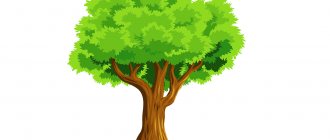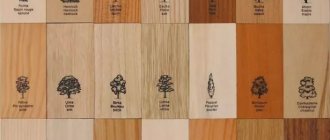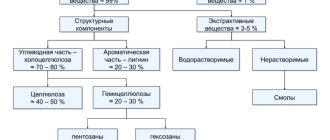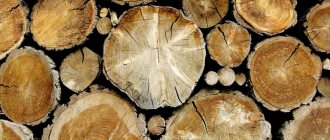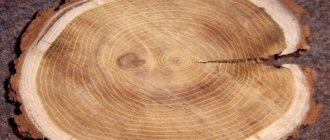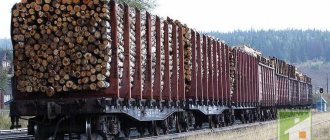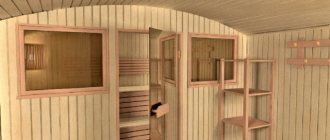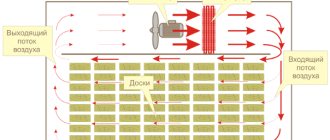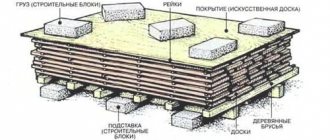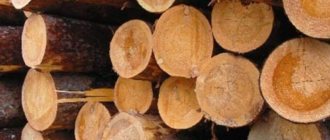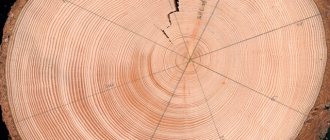As the tree grows, it fills with water from the ground through its roots. This way it absorbs nutrients that promote development. Then, when the trunk is cut down into blanks, some of the moisture remains with it. Wood moisture content should not exceed 22%. Below 15% it will not be possible to dry it naturally, since the external environment also feeds the material with liquid. The indicator of the amount of moisture affects the properties of wood and how it will behave during processing. Excessive amounts of water lead to mold and rot.
Natural humidity
The indicator is used to determine the amount of water inside the trunk immediately after cutting or during growth. It determines the quality of drying of wood materials. The natural moisture content of wood is considered the initial value, on the basis of which calculations for drying the material begin. If the indicator is determined incorrectly, there is a risk of under- or over-drying the lumber.
What percentage of water is contained in the trunk is determined by the following factors:
- wood structure;
- porosity;
- environment.
The natural moisture content of wood ranges from 30 to 80% and varies depending on the type of material. They are used as a starting point before determining the optimal drying mode to achieve the desired quality of the dry workpiece.
| Breed | Humidity, % | ||
| Cores | Sapwood | Average | |
| Birch | — | 70-90 | 78 |
| Oak | 50-80 | 70-80 | 70 |
| Spruce | 30-40 | 100-120 | 91 |
| Larch | 30-40 | 100-120 | 82 |
| Aspen | — | 80-100 | 90 |
| Pine | 30-40 | 100-120 | 88 |
| Ash | 35-40 | 35-40 | 38 |
| Fir | — | — | 101 |
| Cedar | — | — | 92 |
Deciduous wood has a lower natural moisture content than coniferous wood. This is due to the structure of wood. Spruce contains up to 90% moisture, fir contains up to 92%. For comparison, ash wood contains only 36%. In addition, the percentage of water in the material is influenced by the state of the environment. In winter, plants go into “dormant mode” and practically do not consume nutrients from the ground. Therefore, humidity in summer is much higher than in winter. Also, freshly cut wood has a much higher moisture percentage than older wood.
The task of those involved in lumber processing is to reduce moisture content to the lowest possible percentage. This is done so that the workpieces acquire the necessary hardness and strength. The wear and tear of products whose material has successfully undergone the drying process is significantly lower.
Humidity also affects the size of the workpieces. The more the material dries out, the smaller in size it becomes. Proper drying should be organized in such a way that moisture evaporates evenly. Then the weight and size of the workpiece will be standard, and the material itself will acquire the necessary properties. The latest methods of drying wood reduce the percentage of humidity to 6. This indicator also depends on the species, structure of the tree, and time of year.
Heavily dried wood is not used for construction, as it can crack. The amount of water in the material for these purposes is reduced in the following ways:
- Self-drying. A ready-made cut of natural moisture is purchased and laid out in stacks on the site. Gaps are made between the rows of boards using bars so that air can circulate freely. The supports must be placed at least 1.5 meters apart from each other, and the material will not bend. To prevent rain or other precipitation from spoiling the wood, the structure is covered with film or roofing felt on top. Natural drying is best done in the warm season. Materials are placed in the shade, under a canopy. Thin-width boards will dry out faster than thick ones. The structure is installed on pads made of pine branches or protective material.
- Purchase of finished material. In this case, the seller has already prepared the boards and dried them naturally on his own.
- If it is necessary to reduce the amount of moisture to 15% or lower, then chamber drying is used indoors. Such materials will be more expensive, since processing will require a large waste of resources. And it is better not to use such wood for construction, it can crack.
The ideal use of dry wood is furniture and interior items.
Wood moisture content and properties associated with its change.
The concept of moisture content is used to quantify the water content in wood.
Humidity is the ratio, expressed as a percentage, of the mass of water contained in the sample to the mass of dry wood: W = (M - M0) / M0 * 100, where M is the initial mass of the wood sample, g, and M0 is the mass of the absolutely dry wood sample, g .
Humidity can be measured by direct or indirect methods. Direct methods are based on the release of water from wood, for example by drying. These methods are simple, reliable and accurate, but quite time consuming. Indirect methods, which are based on measuring other physical properties that depend on the water content in wood (for example, electrical conductivity), do not have this drawback. Conductometric electric moisture meters are the most widely used. But indirect methods have their drawbacks: they give reliable readings at wood moisture content in the range from 7 to 30% and only at the point of insertion of needle contacts.
Water in wood can be in two forms: bound or free. Bound water is located in the cell walls and is retained mainly by physicochemical bonds; a change in its content greatly affects most of the properties of wood. Free water is contained in cell cavities and intercellular spaces and is retained only by mechanical bonds. Free water is removed more easily than bound water and has less effect on the properties of the wood.
When tests are carried out to determine the physical and mechanical properties of wood, it is brought to a normalized moisture content of 12%.
According to the degree of moisture content, wood can be:
wet, W > 100%, been in water for a long time;
freshly cut, W = 50-100%, retaining the moisture of the growing tree;
air-dry, W = 15-20%, kept in the open air;
room-dry, W = 8-12%, kept in a warm room for a long time; absolutely dry, W = 0, drying was carried out at a temperature of t=103±2°C.
Shrinkage is a reduction in the linear dimensions and volume of wood when bound water is removed from it. Removing free water does not cause shrinkage. The more cell walls there are in a unit volume of wood, the more bound water it contains and the higher the shrinkage.
shrinkage in the tangential direction is 1.5 - 2 times greater than in the radial direction.
Complete shrinkage (or maximum shrinkage Bmax) is a decrease in the linear dimensions and volume of wood when the entire amount of bound water is removed.
The formula for calculating total shrinkage, %, is:
Bmax = (Amax - Amin) / Amax * 100
where Amax and Amin are the size (volume) of the sample, respectively, at a humidity equal to or above the saturation limit of the cell walls and in an absolutely dry state, mm (mm3).
Complete linear shrinkage of wood of common domestic species in the radial direction is approximately 3-7%, in the tangential direction 8-10%, and along the grain 0.1-0.3%. Total volumetric shrinkage is about 11-17%.
shrinkage is taken into account when sawing logs into boards (allowances are made for shrinkage), when drying lumber, etc.
As a result of unequal changes in body volume during drying, internal stresses arise in the wood that are not associated with external loads.
Total drying stresses can be considered as a combination of two components - moisture and residual stresses.
Humidity stresses are caused by non-uniform shrinkage of the material. In the surface part of the board, where the humidity is lower than in the center, tensile stresses arise due to the constraint of free shrinkage, and compressive stresses arise inside the board. Residual stresses are caused by the appearance of heterogeneous residual deformations in wood. Residual stresses, unlike moisture stresses, do not disappear when the humidity in the board is equalized and are observed both during drying and after its complete completion.
If tensile stresses reach the tensile strength of wood across the grain, cracks appear. This is how surface cracks appear at the beginning of drying and internal cracks at the end of drying.
Warping is a change in the shape of lumber and blanks during drying, sawing or improper storage. Warping can occur due to differences in shrinkage in different structural directions. There are transverse and longitudinal warping. Transverse warping can be: grooved, trapezoidal, diamond-shaped, oval. Longitudinal warping occurs along the edge, along the face and winging.
Warping can occur during mechanical processing of dry lumber: during asymmetrical planing, rib division due to imbalance of residual stresses.
Moisture absorption is the ability of wood, due to its hygroscopicity, to absorb moisture (water vapor) from the surrounding air. Moisture absorption practically does not depend on the breed. Dry wood placed in a very humid environment becomes heavily moistened, which worsens its physical and mechanical characteristics and reduces its biostability. To protect wood from the influence of moist air, the surface of wooden parts and products is covered with paints and film materials.
Swelling is an increase in the linear dimensions and volume of wood with an increase in the content of bound water in it. Swelling occurs when wood is exposed to moist air or water. This is a property that is the opposite of shrinkage and obeys basically the same laws. Just like shrinkage, the greatest swelling of wood is observed in the tangential direction across the grain, and the least - along the grain.
Swelling is a negative property of wood, but in some cases it is beneficial, ensuring the density of joints (in barrels, vats, ships, ax handles).
Water absorption is the ability of wood to increase its moisture content in direct contact with droplet water. The maximum moisture content that wood immersed in water reaches is the sum of the maximum amount of bound water and the maximum amount of free water. The amount of free water depends on the volume of cavities in the wood, therefore, the greater the density of the wood, the lower its moisture content, which characterizes maximum water absorption.
The ability of wood to absorb water, as well as other liquids, is important in the processes of cooking wood to obtain cellulose, when impregnating it with solutions of antiseptics and antipyrines, and when rafting wood.
Density _ This property is characterized by the mass of a unit volume of material, and has a dimension in kg/m3 or g/cm3.
a) Density of wood substance Рд.в., g/cm, i.e. the density of the cell wall material is equal to: Rd.v. = Md.v. / Vd.v., where Md.v. and Vd.v. - respectively, the mass, g, and volume, cm3, of the woody substance.
This indicator is equal to 1.53 g/cm3 for all species, since the chemical composition of the cell walls of wood is the same.
b) The density of absolutely dry wood P0 is equal to: P0 = M0 / V0, where M0, V0 are, respectively, the mass and volume of wood at W = 0%.
The density of wood is less than the density of wood substance, since voids (cell cavities and intercellular spaces filled with air) are taken into account.
The relative volume of cavities filled with air characterizes the porosity of wood P: P = (V0 - Vd.v.) / V0 * 100, where V0 and Vd.v. - respectively, the volume of the sample and the wood substance contained in it at W = 0%. Wood porosity ranges from 40 to 80%.
c) Density of wet wood : Pw = Mw / Vw, where Mw and Vw are, respectively, the mass and volume of wood at humidity W. The density of wood depends on its moisture content. When humidity W is less than Wpn, the density changes insignificantly, and with an increase in humidity above Wpn, a significant increase in the density of wood is observed.
d) Partial moisture content of wood P`w characterizes the content (mass) of dry wood per unit volume of wet wood: P`w = M0 / Vw, where M0 is the mass of absolutely dry wood, g or kg; Vw is the volume, cm3 or m3, of wood at a given moisture content W.
e) The basic density of wood is expressed by the ratio of the mass of an absolutely dry sample M0 to its volume at a moisture content equal to or above the cell wall saturation limit Vmax: Pb = M0 / Vmax. This basic indicator of density, which is independent of humidity, is widely used to assess the quality of raw materials in the woodworking, pulp and paper industries and in other cases.
The density of wood varies over a very wide range. Among the species of Russia and neighboring countries, wood with a very low density is Siberian fir (345), white willow (415), and the most dense is boxwood (1040), pistachio kernel (1100). The range of changes in the density of foreign wood species is wider: from 100-130 (balsa) to 1300 (backout). Density values here and below are given in kilograms per cubic meter (kg/m3).
According to the density of wood at 12% moisture content, species are divided into 3 groups:
low density P12 < 540,
average density 550 < P12 < 740,
high density P12 > 740.
Permeability is the ability of wood to allow liquids or gases to pass under pressure.
The water permeability of wood along the fibers is much greater than across the fibers, while in hardwood it is several times greater than in coniferous wood.
Equilibrium humidity
In order for lumber to be stored for a long time and not rot, it must be properly dried. To carry out the procedure, you will need an indicator of the equilibrium moisture content of the wood. It is achieved by long-term exposure of lumber to a certain external environment. When external conditions change, the equilibrium humidity also changes.
| Equilibrium moisture content of wood at different temperature and humidity conditions in winter huts | ||||||
| Month | In the external environment | In winter huts | ||||
| Air temperature, C | Air humidity, % | Equilibrium moisture content of wood, % | Air temperature, C | Air humidity, % | Equilibrium moisture content of wood, % | |
| April | 8,8 | 59 | 11,4 | 5,9 | 79 | 15,7 |
| May | 17,0 | 49 | 9,3 | 8,3 | 86 | 16,7 |
| June | 20,6 | 53 | 10,0 | 10,5 | 92 | 21,0 |
| July | 18,0 | 54 | 10,3 | 12,4 | 90 | 20,9 |
| August | 16,4 | 69 | 13,1 | 11,6 | 87 | 19,5 |
| September | 14,3 | 72 | 13,0 | 11,8 | 84 | 16,1 |
| October | 6,3 | 63 | 9,0 | 5,9 | 68 | 11,6 |
| November | -4,1 | 85 | 17,4 | -4,1 | 65 | 10,6 |
Excessive amount of moisture in the rock negatively affects the condition of the finished product and spoils the workpiece. Lumber becomes moldy when exposed to water, and fungus grows in it. Wood is porous in structure and absorbs moisture easily. It is also easy to get rid of it by decreasing or increasing in size. As a result, if the indicator is calculated incorrectly, some areas of the wooden structure may begin to bulge over time or settle. And then, under the influence of the external environment, they will be smoothed out again.
The degree of humidity in coniferous and deciduous species is different. For clear sorting of lumber, it is divided into 3 grades according to the percentage of water in the composition:
- Raw wood. Contains more than 35% moisture.
- Semi-dry. In the range from 25 to 35%.
- Dry. Less than 25%.
The following is a table of the equilibrium moisture content of wood depending on temperature and relative humidity:
| t, C | Relative humidity, % | |||||||||||||
| 35 | 40 | 45 | 50 | 55 | 60 | 65 | 70 | 75 | 80 | 85 | 90 | 95 | 98 | |
| 0 to 5 | 7,1 | 7,9 | 8,7 | 9,5 | 10,4 | 11,3 | 12,4 | 13,5 | 14,9 | 16,5 | 18,5 | 21,0 | 24,3 | 26,9 |
| 10 | 7,1 | 7,9 | 8,7 | 9,5 | 10,3 | 11,2 | 12,3 | 13,4 | 14,8 | 16,4 | 18,4 | 20,9 | 24,2 | 26,8 |
| 15 | 7,0 | 7,8 | 8,6 | 9,4 | 10,2 | 11,1 | 12,1 | 13,3 | 14,6 | 16,2 | 18,2 | 20,7 | 24,1 | 26,8 |
| 20 | 6,9 | 7,7 | 8,5 | 9,2 | 10,1 | 11,0 | 12,0 | 13,1 | 14,4 | 16 | 17,9 | 20,5 | 23,9 | 26 |
| 25 | 6,8 | 7,6 | 8,3 | 9,1 | 9,9 | 10,8 | 11,7 | 12,9 | 14,2 | 15,7 | 17,7 | 20,2 | 23,6 | 26,3 |
| 32 | 6,7 | 7,4 | 8,1 | 8,9 | 9,7 | 10,5 | 11,5 | 12,6 | 13,6 | 15,1 | 17,0 | 19,5 | 22,9 | 25,6 |
| 40 | 6,5 | 7,2 | 7,9 | 8,7 | 9,5 | 10,3 | 11,2 | 12,3 | 13,6 | 15,1 | 17,0 | 19,5 | 22,9 | 25,6 |
| 45 | 6,3 | 7,0 | 7,7 | 8,4 | 9,2 | 10,0 | 11,0 | 12 | 13,2 | 14,7 | 16,6 | 19,1 | 22,4 | 24,7 |
| 50 | 6,1 | 6,8 | 7,5 | 8,2 | 8,9 | 9,7 | 10,6 | 11,7 | 12,9 | 14,4 | 16,2 | 18,6 | 22,0 | 24,7 |
| 55 | 5,9 | 6,6 | 7,2 | 7,9 | 8,7 | 9,4 | 10,3 | 11,3 | 12,5 | 14,0 | 15,8 | 18,2 | 21,5 | 24,2 |
| 60 | 5,7 | 6,3 | 7,0 | 7,7 | 8,4 | 9,1 | 10,0 | 11,0 | 12,1 | 13,6 | 15,3 | 17,7 | 21,0 | 23,7 |
With natural drying, the figure decreases to 30%. At the same time, the dimensions and weight of the material change. To speed up the process, technologies are used that allow it to be reduced to 7-18% in a short period.
The influence of wood structure on its properties
The structure of the fiber has a direct impact on the characteristics of lumber. Experts note a direct relationship between density and hardness. It is not directly proportional, but noticeable. The popularity of coniferous species is due to optimal characteristics that are ideal for solving the tasks for which they are used. They are light in weight and sufficiently durable. They are easy to process even for simple home craftsmen. Valuable breeds require special skills and professional tools.
The moisture content of wood has a great influence on the properties. When dry, it is more difficult to process. For this reason, the initial cutting is carried out while the wood is wet. Some technological operations require forced humidification. This practice is used in large woodworking enterprises in order to speed up the process. In addition, forced drying is carried out much faster if the workpiece is not large. It is considered optimal to remove moisture from the boards. The operation is quite short in time and does not lead to severe warping of the lumber, as would be the case if slats and timber were placed in the drying chamber.
Free and bound moisture
When a tree is cut down and lies in a warehouse, moisture is distributed evenly along the trunk. A fairly long period of time must pass before this happens. Immediately after cutting, the humidity is increased, reaching an average of 60%. The moisture inside the trunk is divided into:
- hygroscopic (free), which is retained in the fibers;
- capillary (connected), contained in plant cells.
During the drying process, only free moisture comes out of the trunk. The capillary remains. It is only about 23% in wood. If the lumber was cut down recently, the moisture will be distributed unevenly along the length of the trunk. The highest percentage is observed in the butt part, the closer to the top, the lower the percentage becomes. There is also a dependence of the amount of moisture in wood in some species on proximity to the core. In some it increases as it approaches the core, in others, on the contrary, it decreases.
Table of lumber moisture indicators:
| Wood type | Humidity indicator, % | A comment |
| Wet | Above 100 | Purchased if the material will lie in water for a long time. |
| Freshly cut | 50-100 | The tree was recently felled |
| Air dry | 15-20 | Characteristic of material that has been stored in air for a long time. |
| Chamber drying | 8-12 | Lumber is kept in a heated room for a long time |
| Absolutely dry | 0 | The wood is dried in a special machine |
When water is distributed evenly throughout the entire structure of the wood and does not exceed 15%, this is called standard humidity. In this state, the workpiece can be used for processing and preparation for work (finishing, construction). The material is well stored, but is susceptible to weather conditions; if precipitation occurs, it can get wet and the moisture content will change.
To produce quality wood, it is necessary to use both concepts (standard and equilibrium moisture content). You must understand that when using the finished product outdoors, under the influence of different temperature conditions, its properties may change. Therefore, the product must be protected with impregnation.
The importance of humidity in the construction and renovation industry
Humidity indicators affect a number of operational features of lumber:
- shrinkage and warping of wood;
- ability to withstand temperature changes;
- protection from insects, fungi, mold and other biological factors;
- durability;
- aesthetic characteristics;
- thermal insulation properties.
It is important to take this parameter into account when choosing the optimal material for performing a particular type of work. Mistakes are fraught with unpleasant consequences both at the construction stage and during subsequent operation.
Wood fiber saturation point
This is an indicator of equilibrium humidity, at which free moisture from the wood has already evaporated, but capillary moisture remains. The percentage of humidity at the saturation point ranges from 23 to 30. Depends on the type of wood and external conditions. If the indicator of the presence of moisture is lowered below this point, the drying process will slow down, the material will begin to dry out, shift, and settle. During the natural drying process, the upper layers of the material quickly release free moisture and begin to release bound moisture. As a result, the properties of the workpiece change. This process introduces difficulties into the drying process.
| Breed | Coefficient of shrinkage (Ku) and swelling (Kp) in directions | |||||
| Volumetric | Radial | Tangential | ||||
| Ku | Kr | Ku | Kr | Ku | Kr | |
| Larch | 0,52 | 0,61 | 0,19 | 0,20 | 0,35 | 0,39 |
| Pine | 0,44 | 0,51 | 0,17 | 0,18 | 0,28 | 0,31 |
| Cedar | 0,37 | 0,42 | 0,12 | 0,12 | 0,26 | 0,28 |
| Birch | 0,54 | 0,64 | 0,26 | 0,28 | 0,31 | 0,34 |
| Beech | 0,47 | 0,55 | 0,17 | 0,18 | 0,32 | 0,35 |
| Ash | 0,45 | 0,52 | 0,18 | 0,19 | 0,28 | 0,35 |
| Oak | 0,43 | 0,50 | 0,18 | 0,19 | 0,27 | 0,29 |
| Aspen | 0,41 | 0,47 | 0,14 | 0,15 | 0,28 | 0,30 |
After reaching the saturation point of the fibers, further wetting and drying of the workpiece is no longer as important as before.
What does wood density affect?
We have already mentioned that denser rocks are more difficult to process, especially with hand tools. Even metal gradually gives in after attempts to break the structural bonds of wood fibers, which is why the cutting edge must be sharpened so often. This is also affected by hardness, which has a direct relationship with density.
It is appropriate to process hard and dense rocks with electrically driven tools (drills, engravers) to significantly speed up and simplify the process
Harder rocks are better able to withstand loads and resist damage, but tend to bend less easily and be less resilient.
Hardness is determined by different methods, the most common of which are the Brinell, Rockwell, Monin and Jank tests. Their essence comes down to pressing an object made of metal or other durable materials into the surface of the board and calculating a coefficient from the size of the hole formed or the force that was applied for this manipulation. It doesn’t matter which method is used to determine hardness, the main thing when comparing rocks is to focus on the indicators of the same testing. However, there still cannot be canonical values, since it is impossible to obtain bars that are absolutely identical in structure, so there is always some error and different data in different sources. It is also important to understand that measuring the tangential, radial, and end of a piece of wood will give different measurements.
This is what the apparatus for performing the Janka test looks like:
The density of wood also affects its ability to absorb. A loose and porous block quickly absorbs moisture from the air and swells, but it also better accepts protective oils and impregnations.
Absolute humidity of wood
A physical quantity that displays the amount of moisture in a workpiece relative to the amount of moisture in a completely dry material. In calculations, the absolute moisture content of wood is indicated by the sign - W. The moisture content of completely dry wood is considered equal to 0%. This value is calculated to calculate the parameters of building materials. During the drying process, the weight of lumber constantly decreases. If the humidity in the atmosphere increases, the indicator will begin to increase. This process slows down when the saturation point of the fibers is reached. At this time, the weight of the workpiece will stop falling. This condition is called absolutely dry; its indicator is considered ideal and is taken as a basis for other calculations.
Absolute humidity formula:
W = (mc-mo)/mo× 100
where mс and mo
- this is the mass of wet freshly cut
(mc)
and the mass of dry
(mo)
workpiece.
According to GOST, this concept is interpreted as simply humidity. Sometimes, errors occur during calculations, since the absolutely dry mass of wood, or incomplete weight, is taken into account.
| Wood type | Density kg/m3 | Coefficient of shrinkage (numerator) and swelling (denominator), % | ||||
| at 12% humidity | completely dry | conditional | volumetric | radial | tangential | |
| birch | 630 | 600 | 500 | 0,54/0,56 | 0,26/0,28 | 0,31/0,34 |
| beech | 670 | 640 | 530 | 0,47/0,55 | 0,17/0,18 | 0,32/0,35 |
| oak | 690 | 650 | 550 | 0,43/0,50 | 0,18/0,19 | 0,27/0,29 |
| spruce | 445 | 420 | 360 | 0,43/0,50 | 0,16/0,17 | 0,28/0,31 |
| Linden | 495 | 470 | 400 | 0,49/0,58 | 0,22/0,23 | 0,30/0,33 |
| larch | 660 | 630 | 520 | 0,52/0,61 | 0,19/0,20 | 0,35/0,39 |
| alder | 520 | 490 | 420 | 0,43/0,49 | 0,16/0,17 | 0,28/0,30 |
| aspen | 495 | 470 | 400 | 0,41/0,47 | 0,14/0,15 | 0,28/0,30 |
| Karkaz fir | 435 | 410 | 350 | 0,46/0,54 | 0,17/0,18 | 0,31/0,34 |
| Siberian fir | 375 | 350 | 300 | 0,39/0,44 | 0,11/0,11 | 0,28/0,31 |
| cedar pine | 435 | 410 | 350 | 0,37/0,42 | 0,12/0,12 | 0,26/0,28 |
| Scots pine | 500 | 470 | 400 | 0,44/0,51 | 0,17/0,18 | 0,28/0,31 |
The indicator is expressed as a percentage and can be calculated in the following ways:
- based on the wet and dry mass of the workpiece;
- using data on the amount of moisture in grams and the weight of the workpiece.
For the calculation to be correct, practical manipulations are required.
- A sample of lumber is cut from the workpiece.
- The freshly cut sample is weighed and the data is recorded.
- Next, it is dried until completely dry and weighed again.
- The actual difference between the two indicators is recorded. This gives the mass of water inside the sample.
Further, according to the formula:
W = mв/mо × 100
where mв
is the mass of water, and
mо
is the mass of the sample in its normal state, the relative humidity is calculated.
This way you can determine the percentage of moisture in relation to the entire mass of available lumber.
Conifers
The most popular types of wood in this category are spruce, pine, cedar, and larch. The areas of application of individual breeds where they show their qualities at their best have been identified. Larch is one of the heaviest coniferous species. Material density 580 kg/m3. Valued for its strength and ability to withstand moisture. The lightest type is cedar wood. Density - 420 kg/m3. It has a pleasant aroma, which is considered medicinal, so it is often used to make household utensils and furniture. The density of spruce is slightly higher - 430 kg/m3. It is used both for power building structures and as a finishing material. The most popular material on the market is pine, whose wood density at different humidity levels can range from 500 to 800 kg/m3. Sales volumes of coniferous species significantly exceed the same figure for deciduous forest species.
Moisture content of wood species
The type of wood determines the reaction of lumber to atmospheric phenomena, the ability to absorb moisture and evaporate it. Some trees are more resistant to moisture, others absolutely cannot tolerate a humid climate and treatment with water, while others fill quickly and dry easily.
| Wood type | Specific gravity (density of wood in t./m3) | ||||
| Humidity | Fresh | 70 % | 25 % | 15 % | 10 % |
| Pine | 0,82 | 0,72 | 0,54 | 0,51 | 0,47 |
| Spruce | 0,76 | 0,64 | 0,47 | 0,45 | 0,42 |
| Birch | 0,87 | 0,89 | 0,67 | 0,64 | 0,60 |
| Aspen | 0,76 | 0,71 | 0,53 | 0,50 | 0,47 |
| Alder | 0,81 | 0,75 | 0,55 | 0,53 | 0,49 |
| Oak | 0,99 | 0,99 | 0,74 | 0,72 | 0,67 |
| Larch | 0,94 | 0,93 | 0,70 | 0,67 | 0,63 |
| Maple | 1,05 | 0,99 | 0,74 | 0,70 | 0,68 |
| Linden | 0,75 | 0,71 | 0,54 | 0,50 | 0,49 |
| Siberian fir | 0,68 | 0,54 | 0,40 | 0,38 | 0,35 |
| Caucasian fir | 0,72 | 0,62 | 0,46 | 0,44 | 0,41 |
| Cedar | 0,76 | 0,62 | 0,46 | 0,44 | 0,41 |
| Beech | 0,92 | 0,89 | 0,71 | 0,68 | 0,64 |
| Elm | 0,94 | 0,88 | 0,69 | 0,66 | 0,61 |
| Ash | 0,96 | 0,93 | 0,73 | 0,69 | 0,64 |
| Hornbeam | 1,06 | 1,13 | 0,84 | 0,81 | 0,67 |
Oak and merbau are the least susceptible to changes in a humid climate. Beech and pear actively absorb water and also dry easily. Kempas has the same properties.
Those trees with a loose structure that dry easily can quickly dry out and then cracks and chips will appear on them. Dense rocks, less susceptible to moisture, do not change their properties when exposed to water. Coniferous wood is initially wetter than deciduous wood. Moreover, the indicator increases closer to the central part of the trunk, while deciduous trees have the same percentages throughout the trunk.
Some carpentry uses water to shape the material into the desired shape. This is called wood moisture, and its value ranges from 6-8%. Under such conditions, the material is easier to sharpen, cut, sand, etc. Dry wood glues more easily, is not susceptible to rotting, and warps slightly.
If the material is initially wet or freshly cut with a high percentage of moisture, it needs to be dried a little before transportation, otherwise it simply may not reach its destination. Transport moisture content of lumber is 18-20%. Before such lumber is loaded and sent by transport, it is aged outside for about 2.5 months. To speed up the process, special drying chambers were invented, and drying was reduced to 5 days. After achieving the required parameters, the wood becomes resistant to atmospheric influences and retains its dimensions until it arrives for further processing.
Benefits of Siberian larch
Scientists have determined that there is a connection between the presence of moisture in wood fibers and the productivity of the plant itself. The ratio of these two parameters determines the water consumption coefficient. So some rocks use more moisture to create organic matter than others. It is enough to compare water consumption indicators to understand which wood is wetter and requires additional processing in the production of lumber.
Oak consumes 340 kg of water to create 1 kg of photosynthesis products, pine - 300, and Siberian larch only 260. This feature makes larch wood as dry as possible during harvesting and resistant to moisture during operation. During the aging process, materials made from this unique tree acquire waterproofing properties.
Methods for determining the degree of humidity
The methods by which wood moisture can be measured depend on the type of material and atmospheric environment. Each breed has its own measurement standards.
The main methods for determining the degree are considered to be weight and electronic. The indicators may differ slightly from each other, but the difference is not significant.
Method 1. Weight
To measure the amount of moisture in a sample you will need a saw, a board, a ruler and an accurate scale.
Stages:
- A sample of wood is taken from the middle of the board. To do this, use a saw to cut a small piece 1-2 cm wide. Important: the sample is taken from the middle part of the board; the moisture concentration is optimal in the center. The edges of the lumber are usually drier, since moisture evaporates from there at the very beginning of drying.
- The sample is cleared of bark or other unnecessary elements and measured on a scale. The result obtained is recorded. For example, the value M0 will indicate the initial mass of the sample.
- The sample is sent to a special drying apparatus under the influence of heat up to 100 degrees Celsius. There the block is dried to a completely dry state.
- The next control weighing is carried out after 5 hours. The sample mass value is written as M1. Subsequent weight readings are taken at intervals of two hours.
- It is necessary to dry the sample until the number on the scale begins to show the same value. This means that the result has been achieved and the sample has become completely dry. The last indicator is designated as MS.
- Using the formula:
W = (M0 - MC): (MC × 100%)
where W
- the desired humidity,
M0
- the first weight,
MC
- the last weight.
To obtain a reliable result, it is recommended to carry out the procedure with several samples.
Hardwood
Unlike coniferous species, this category is less often used in construction. The advantage of deciduous wood is its high strength and decorative qualities. There are a lot of types. These include domestic species: oak, ash, birch and others. Today you can often find exotic species growing in Asia, Australia and America. The practical use of hardwood in construction is limited by its high cost and complexity of processing. There are two types that are readily used in this area. These are aspen and birch lumber. Linden is a soft type of hardwood. It is valued for its uniform structure and ease of processing. For this reason, it is often used for carved decoration and furniture.
Oak occupies a special place in the market. Strong, durable and very beautiful material. The specific gravity of oak is of practical importance. The average density of the rock is 700 kg/m3, that is, one and a half times more than that of pine with similar humidity levels. However, its strength is approximately twice as high. The degree of looseness of pine, spruce and other conifers is higher, so it is preferable to make furniture, floors and decorative elements from oak and related species.
Determination of wood weight at natural moisture content
The consumer needs to know the weight of wood for:
- Transportation of purchased raw materials – selection of transport and payment for delivery.
- Determination of the weight of the finished structure - installation of the foundation and installation of floors.
- Determining the storage location of the material.
Calculating the weight of the material you buy is very easy. To do this, you will need to determine the specific gravity of specific wood from the table and multiply it by the number of cubes of purchased material.
